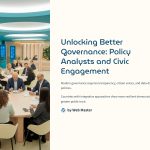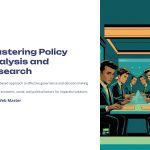 The role of policy analysts is rapidly evolving, intersecting with the expanding field of civic engagement research. In 2025, governments and institutions face mounting pressure to enhance transparency, include citizen voices, and create data-driven yet human-centered policies. This transformation is fueled by digital platforms, open data initiatives, and an increasingly informed public demanding accountability. As a result, the convergence of policy analysis with public participation is no longer optional—it is the foundation of modern governance. Exploring how policy analysts can work alongside civic researchers to harness the power of participatory policymaking is not just timely, but essential. Countries adopting these integrative approaches show more resilient democracies, improved policy outcomes, and greater public trust. This blog post dives deep into the evolving duties of policy analysts, how civic engagement studies are guiding inclusive practices, and what this means for the future of policy design.
The role of policy analysts is rapidly evolving, intersecting with the expanding field of civic engagement research. In 2025, governments and institutions face mounting pressure to enhance transparency, include citizen voices, and create data-driven yet human-centered policies. This transformation is fueled by digital platforms, open data initiatives, and an increasingly informed public demanding accountability. As a result, the convergence of policy analysis with public participation is no longer optional—it is the foundation of modern governance. Exploring how policy analysts can work alongside civic researchers to harness the power of participatory policymaking is not just timely, but essential. Countries adopting these integrative approaches show more resilient democracies, improved policy outcomes, and greater public trust. This blog post dives deep into the evolving duties of policy analysts, how civic engagement studies are guiding inclusive practices, and what this means for the future of policy design.

The Changing Role of Policy Analysts in a Participatory Age
Policy analysts are no longer confined to backroom number crunching or abstract theoretical frameworks. In today’s participatory policy environment, they must also be communicators, facilitators, and bridge-builders between government agencies and the public. This shift stems from a growing recognition that top-down policymaking is insufficient to tackle the complexities of modern issues—from climate change to digital equity.
Analysts now integrate data with community input, interpret civic trends, and help translate public concerns into actionable policy recommendations. They act as knowledge translators, ensuring that diverse voices are not only heard but meaningfully embedded in the decision-making process. The OECD and World Bank have both issued recent reports urging governments to expand the scope of policy analysis to include participatory tools and inclusive metrics.

Civic Engagement Research: Mapping the Voice of the People
Civic engagement research studies how citizens interact with policymaking, and how those interactions can lead to more effective, legitimate governance. Researchers track how public sentiment forms and shifts, analyze participation barriers, and measure the impact of various engagement strategies. In doing so, they provide data that complements the work of policy analysts.
New methods such as deliberative polling, participatory budgeting, and digital town halls offer empirical insights into how democratic processes can be made more inclusive. For instance, South Korea’s digital participation portal and Finland’s experiments with random citizen assemblies are often cited as successful models. These case studies are shaping new norms, pushing civic engagement beyond symbolic gestures toward measurable impact.

Integrating Public Input into Policy Design
Integrating citizen input into policy isn’t just about listening—it’s about co-creating. That means giving the public tools and frameworks that allow them to shape policy outcomes. The role of the policy analyst is pivotal here. They synthesize citizen input with legal frameworks, budgetary constraints, and technical feasibility.
Policy labs and innovation hubs are now co-designing policies alongside community representatives. In Korea, the Government Innovation Lab operates cross-functional teams including analysts, researchers, and citizens. These collaborations have resulted in policies that are more responsive, equitable, and future-proof. Analysts must become skilled in facilitation and data visualization to effectively convey insights from civic feedback.

Challenges in Bridging Policy Analysis and Civic Engagement
Despite the momentum, challenges persist. One major issue is the lack of standardized frameworks for integrating public input across different governance levels. Local governments may embrace participatory methods, while national institutions lag behind. Furthermore, there’s the risk of tokenism—where public engagement becomes a checkbox activity rather than a meaningful collaboration.
Policy analysts also struggle with data reliability, bias in engagement tools, and balancing expert insight with popular opinion. This makes their job more complex but also more critical. They need to assess participatory quality, not just quantity, and advocate for policies that reflect nuanced societal needs, not just majority voices.

Future Skills for Policy Analysts in a Participatory Era
The skill set of policy analysts is undergoing a transformation. Beyond traditional competencies like statistical analysis and legislative knowledge, new skills are rising to prominence. These include public facilitation, digital tool proficiency, stakeholder mapping, and empathy-based design thinking.
Courses and certifications in civic tech, participatory governance, and behavioral policy are gaining popularity. Analysts are also expected to be agile communicators who can translate complex insights for both decision-makers and citizens. Governments are restructuring training programs to include scenario planning, co-design workshops, and ethnographic research methods—placing citizens at the core of policy education.

Conclusion: Toward a More Collaborative Policy Future
The synergy between policy analysts and civic engagement researchers is unlocking new potentials for participatory governance. As we move forward, institutional support, innovative tools, and a culture of mutual respect between citizens and policymakers will be essential. It’s not just about making policy—it’s about making policy together.
Nations that invest in this dual approach are likely to craft smarter, more sustainable policies while rebuilding the social contracts that democratic societies depend on. Whether you’re a policymaker, analyst, researcher, or engaged citizen, your role in shaping collaborative governance has never been more important.
*Capturing unauthorized images is prohibited*







